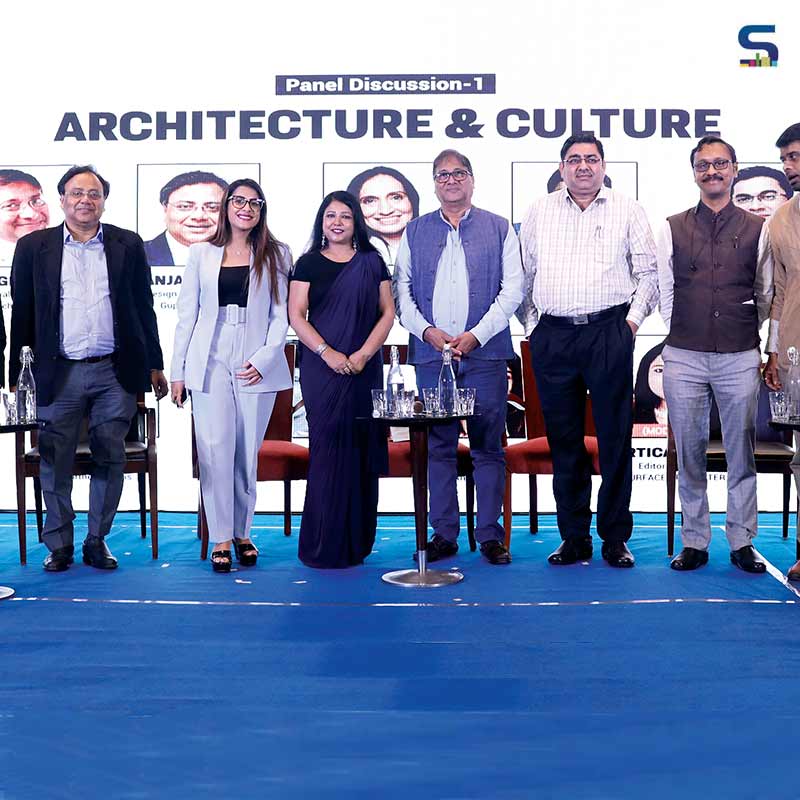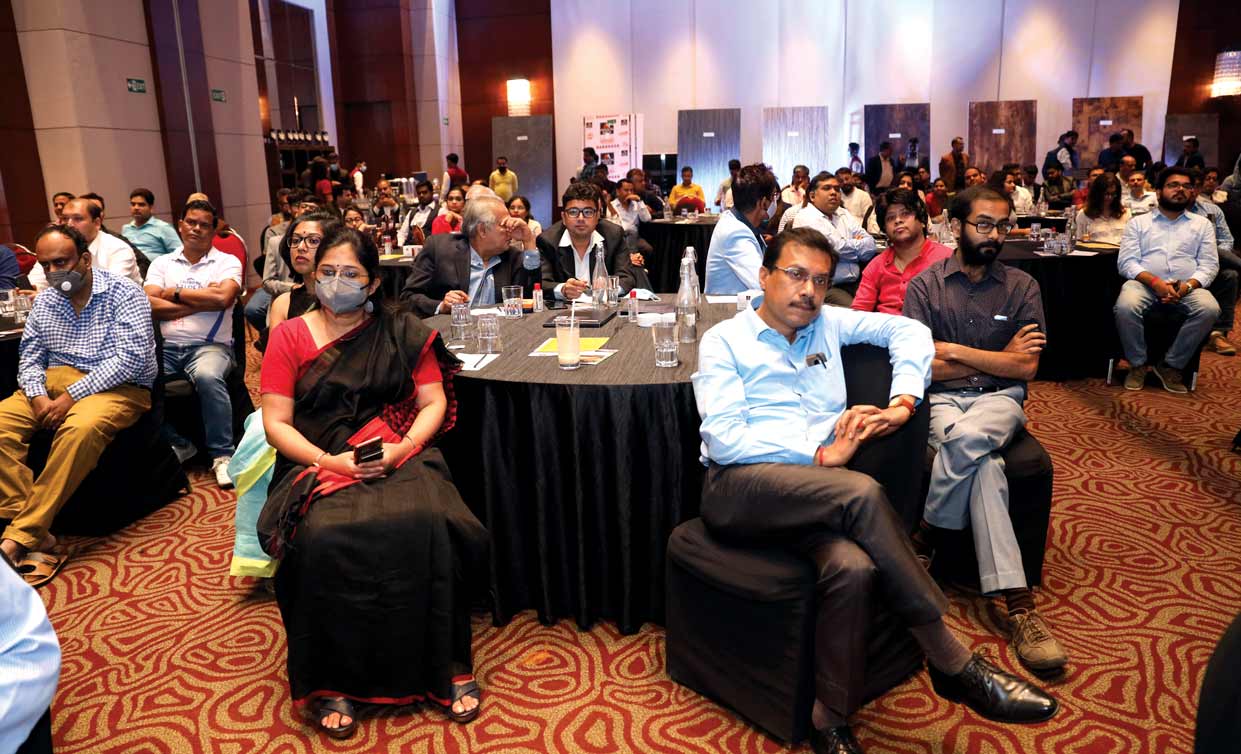
Due to its strategic location and varied monarchical and bureaucratic rules, Kolkata has experienced a continuous cultural upheaval which is clearly reflected in its architecture. It is safe to say that the cultural impression is deeply embedded in the architecture of the city. The advent of modern era has made a distinguished impression on the city and has clearly demarcated the city architecturally. SURFACES REPORTER (SR), during its notable architecture and design event, The Talk of Town Kolkata, spoke to the eminent architects and designers of the city and tried to find out how the city has grown architecturally over the decades weaving the architecture, art and culture together.
Kolkata- The center of Power and culture
Talking about how old and new and poor and rich mingle together in Kolkata, Ar Monica Khosla Bhargava, Principal, Kham Consultants stressed over the fact that people from all strata of society coexist here. She said, “Architecture has the capacity to provide for everyone. An architecture that divides is not desired. One of my favourite buildings in Kolkata is the ITC Sonar Bangla by Kerry Hill. While this building is not accessible to all, it gives the entire experience of Bengal. In a rural Bengal, you can hear the sound of tree and lights of jugnu. When I enter ITC Sonar Bangla, the way the dark Granite, the water and the light flicker, it gives you that immersive experience. The designer has given an experience of a village in Bengal. That is the kind of nonaggressive architecture we should promote through design and should be our future.”
Talking about the same, Manash Sinha Roy, Principal, Practice Design, “Kolkata itself is culturally very strong. Mingling up with the existing culture, whatever the city has or whatever we have got as an inherit from the past, its relatively easier to take it forward from there. There is less scope for Indian buildings within the urban fabric. I think it’s more important we try to be within the limitations, it should not be limitations but we should be within some kind of benchmarks which have been set.”
Abhijit Saha, Principal, Decofloor, says, “It’s a vast subject. Architecture always shows its own culture. It’s a very timeline practice. It depends on time to time based on your invention, time and knowledge which is increased from time to time. Architecture reflects that way. Calcutta is an old city from the British period. Its legacy was over 300 years here. Many more old architectures are here, by the development of time, many more new structures, new architecture, new buildings, new interiors are developing in that manner. Architecture of Calcutta is changing by its culture, by the time and by its choice, which reflects in time.

Architecture has the capacity to provide for everyone. An architecture that divides is not desired. - Ar. Monica Khosla Bhargava Principal, Kham Consultants Kolkata
Changes in architecture and Culture over the years
Architecture exists to create built environment and culture for the people. It is a representation of how we see ourselves and the world. Emphasizing the same, Ar Anjan Gupta, Principal, Anjan Gupta Architects, said, “Kolkata is a linear city. On one side it has Ganges and due to other geological constraints, we can only expand in the eastern direction. Therefore, the development is more towards the eastern side. There is also a cultural rivalry between North and South Kolkata. While South is more elite, north is a mixed group. We call it city of joy but at the same time the city of palaces as well. North Calcutta couldn’t grow since it is densely populated and the buildings here have no space in between whereas South Calcutta, with all its wealth is making high rises.
This city is a confluence with different traditions. You can see Jewish synagogue, Armenian garni, cathedral, Jain temples, Hindu temples, Sikh gurudwara, means worshipping places for all religions. The religious architecture definitely cultivates the history of architecture heritage. Architecture across the culture definitely served purpose to create concrete documentations for social, cultural, economic and political dynamics. In short, the architecture tells you the difference between the buildings, that is, how they are built over a period of time. That’s how the story is scripted for the city. For instance, you can see separate neighbourhoods for the potters, the cobblers, jewellers, there are separate neighbourhoods but they blend seamlessly. While earlier the entire city was like a big family, the culture is changing now. There is a clear shift towards nuclear families and apartment culture where privacy is a major requirement in terms of design as well as everybody be it husband and wife, requires their private space which is adhered by the architects and interior designers. Today, the focus for culture is to get most out of the building

There is a lack of sensitivity from government officials and stakeholders who have the decision making power but are not architecturally conscious and thus make wrong decisions. Ar. Sunil Maniramka Principal, Maniramka & Associates, Kolkata

We need to get into the aspect of Architecture and Culture with an open mind and think about it in a very loud manner rather than sticking to the idea of having anything. Somehow we confuse Heritage with culture. - Ar. JP Agrawal Principal, Agrawal & Agrawal Architects, Kolkata
Modern Architecture- Scope and beyond
Kolkata is like a melting pot of culture with the finest legacy. However many architects believe that slowly the culture is getting lost due to the haphazard development of the city. Ar Sunil Maniramka, Principal, Maniramka and Associates says, “As the city is evolving and developing, people are destroying its heritage in the name of development. As a good part, a new breed of architects have come up who are very sensitive to the work they are doing. Like a good architect, they are not only doing good buildings but are also following culture and context. However, since such architects are very less, the bulk of projects are being carried out unorganized sector consisting of people who are anything but architect and manage to design building without a soul just like a copy paste thing.
There is a lack of sensitivity from government officials and stakeholders who have the decision making power but are not architecturally conscious and thus make wrong decisions.
While Kolkata, with all its heritage, is a strong contender for UNESCO World Heritage City, the lack of government sensitivity is making it weaker. If the government involves all the stakeholders including the Architects, historians, artist etc and bid for a UNESCO World Heritage City, then it will put us on the World Map which will ultimately led to the boom in the economy as well.
Role of ArchitectS in Shaping Kolkata
While every city that took the test of time are very layered, Kolkata has a huge recall value. Talking about the changes that can be brought the way Kolkata is moving forward in terms of design, Ar Aditya Goswami, Founder Partner, Architectonic Services, says, “The problem with architects is that we always want our building to stand out.
.jpg)
Architecture across the culture definitely served purpose to create concrete documentations for social, cultural, economic and political dynamics. In short, the architecture tells you the difference between the buildings, that is, how they are built over a period of time. - Ar. Anjan Gupta Design Principal, Anjan Gupta Architects, Kolkata

While the new architecture has to fuse into the existing architecture but also as the architects, we also have to think a little ‘Hatke’. It has got to be something that is out of the box. - Bipratip Dhar Principal, Epsilon Architecture & Interiors
However in a heritage city like Kolkata, it mustn’t stand out but blend well. The old Kolkata used to have a strong recall value with all its design elements. As Architects we need to be more responsible for urban design not over announce ourselves. We need to be more responsible to learn the urban fabric that a street is trying to speak to us on.”

Adding a little different perspective, about how an architect must also think out of the box while playing the bigger role of the conservationist of the city Ar Bipratip Dhar, Founder, Epsilon, says, “All these structures are kind of extremely good. They are very famous and they are also talked about. While the new architecture has to fuse into the existing architecture but also as the architects, we also have to think a little ‘Hatke’. It has got to be something that is out of the box. I think culture has a bigger role to play but at the same time it has got to be a fusion of old history and an expression of the present day.
Talking about the contribution of Kolkata in terms of design, Ar Kalyan Chakraborty, Partner, Polaris Architect, says, Kolkata has a lot of contribution in the Global architecture which we often miss. One of the greatest architectural style bungalow was developed here. The Britishers learnt from us and gave it a name ‘Bangla’ derived from Bengal. The wrap around ‘Varandah’ becomes a major architectural feature, one that is even relevant today. Recently, in IIT Kharagpur, a building is developed with a double layered façade with a screen wall with hardly any gap between the two screens but basically serving the same purpose. So we can take the cue from our traditional knowledge and Vernacular wisdom and develop something new in future.”
Architectural Internationalism putting our cities’ heritage at risk
The thought-provoking question got a very interesting insight from Ar JP Agrawal, Principal, Agarwal & Agarwal Architects. He says, “There was a controversy of not declaring Dalhousie Square a World Heritage Site. But it wasn’t declared the one as there was a telephone pole just behind it which was an architectural blunder. We need to get into the aspect of Architecture and Culture with an open mind and think about it in a very loud manner rather than sticking to the idea of having anything. Somehow we confuse Heritage with culture. We have seen beautiful Heritage buildings surrounding the four sides of Lal Dighi. But it is all British architecture and not our Indian culture.
Now let’s see the three places of Calcutta. First is the Dalhousie square, Lal Dighi. Second is Park Street and third is the Sector 5. Dalhousie has its own culture, character and fabric leaving apart the telephone tower blunder. But it still got a beautiful heritage of the buildings. Now look at park Street.
If you look at Karnani Mansion you cannot probably know where it is. While in Park Street, you connect food with culture. In the same breadth, Sector 5 has been developed in last 25 years and has been converted into a concrete jungle. But it was the need of the hour. However, what went wrong was, while designing the space, the Street Space was never taken care of. By giving all these examples, I am trying to ascertain that while talking about culture and heritage, we must keep an open mind. Culture is in our DNA.”

One of the greatest architectural style bungalow was developed here. The Britishers learnt from us and gave it a name ‘Bangla’ derived from Bengal. - Ar. Kalyan Chakraborty Partner, Polaris Architect

The problem with architects is that we always want our building to stand out. However in a heritage city like Kolkata, it mustn’t stand out but blend well. - Aditya Goswami Founding Partner, Architectonic Services
SURFACES REPORTER observes that each of the takeaways from this session is meaningful and paves the way for further deliberation.
One of the strongest takeaway we wish to reiterate is from Ar Maniramka, “While Kolkata, with all its heritage, is a strong contender for UNESCO World Heritage City, the lack of government sensitivity is making it weaker. If the government involves all the stakeholders including the Architects, historians, artist etc and bid for a UNESCO World Heritage City, then it will put us on the World Map which will ultimately led to the boom in the economy as well.”